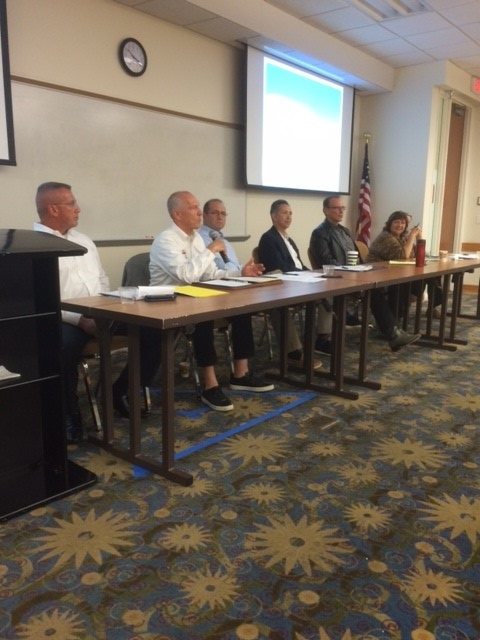By Keith Gibson
It was a city and county management “fantasy camp” of sorts at Florida Gulf Coast University Nov. 3 when an all-star panel of Southwest Florida government administrators gathered on campus for a special training program.
The forum was organized and hosted by Dr. Robert E. Lee, assistant professor in the Department of Political Science and Public Administration and faculty adviser for the International City/County Management Association (ICMA) student chapter. It afforded a group of about 20 FGCU students and 30 other participants from various Southwest Florida government sectors the chance to tap into the leadership skills and mindsets of seven top local administrators.
All the talk centered on the timely topic of “Hurricane Irma: Lessons Learned on Planning, Mitigating and Recovering.” And the best thing about all that talk was that the experts sitting in front of the room in Sugden Hall also walked the walk as the leaders ultimately responsible for the citizens and infrastructure of their respective communities while the strongest Atlantic hurricane in 12 years ripped through Florida on Sept. 10. Irma left an estimated $63 billion in damage in its wake as the fourth-costliest tropical cyclone on record.
For John Szerlag, city manager of Lee County’s biggest city — Cape Coral and its more than 180,000 residents — setting up a unified command structure for emergency operations among the fire and police chiefs, the public works director and himself was the way to go. Once the planning is done, citizens are informed and educated about the situation and the emergency is declared, Szerlag believes the best thing he can do is “let the professionals do their jobs, and in an evacuation, set an example yourself and hit the road.”All the talk centered on the timely topic of “Hurricane Irma: Lessons Learned on Planning, Mitigating and Recovering.” And the best thing about all that talk was that the experts sitting in front of the room in Sugden Hall also walked the walk as the leaders ultimately responsible for the citizens and infrastructure of their respective communities while the strongest Atlantic hurricane in 12 years ripped through Florida on Sept. 10. Irma left an estimated $63 billion in damage in its wake as the fourth-costliest tropical cyclone on record.
“I can delegate authority,” Szerlag added, “but not responsibility.”
To that end, Arcadia City Administrator Terry Stewart and Sanibel City Manager Judie Zimomra both said it’s critical to make sure the right response team is assembled.
“Great leadership always knows when to step in and provide direction, then step back and trust the people you have in position,” said Stewart, who previously served as Cape Coral city manager and Fort Myers Beach town manager, and on this day was celebrating his 48th anniversary working in local government.
Zimomra, who has managed Southwest Florida’s premier island paradise since 2001 and was the only panelist leading the same city for both Irma and Hurricane Charley in 2004, put it this way: “Any employee who’s not a ‘B-plus,’ get rid of them before the emergency. If you think in any way that the ‘C-minus’ or ‘D-plus’ is going to step up, put on a hero’s cap and come forward because it’s an emergency, that’s the biggest mistake you can make.”
Nick Casalanguida, deputy Collier County manager, spoke for many of his peers when he said the biggest lesson learned after Irma was that they underestimated the potential demand for shelter space. In his case, Collier was set up to shelter about 8,000 people, but had to find spots for 17,000 evacuees. FGCU itself ended up as one of the region’s shelters of last resort, with Alico Arena overflowing to the point Lutgert and Marieb halls also had to be used for evacuees, some of whom had special needs and pets in tow — two situations the university was not technically equipped to handle.
In Collier’s case, Casalanguida credited county schools Superintendent Kamela Patton and her team for stepping up and not only opening more of their buildings to handle the overflow, but for working tirelessly to operate the extra shelters as well — a situation similar to that at FGCU, where administrators, faculty and staff were thrust into shelter-management duty. “We were way overwhelmed, and Dr. Patton and her schools staff stepped up in a big way,” Casalanguida said.
The panel also addressed topics such as how they structured debris collection and food-and-supplies distribution, and how advances in technology helped tremendously in storm preparation and response. Social media played a key role in disseminating information to the public before, during and after Irma. Some used live videos taken from drones to not only assess damage for recovery and FEMA compensation purposes, but to post so displaced residents could assess the situation in their neighborhoods before deciding to return home.
Carl Schwing, city manager of Bonita Springs — a community that already was flooded in the weeks before Irma by heavy rains and still has streets under water after getting hit with what he called the “double whammy” of the hurricane — found another use for social media during the event: to quash rumors.
“One post said five or six bodies were floating down the Imperial River, so once we confirmed that wasn’t true, we quickly got the word out to the media,” Schwing said. “My favorite was one that claimed all the monkeys had escaped from Everglades Wonder Gardens (an iconic zoological and botanical attraction in downtown Bonita). My staff, who are far more ‘professional’ than I am, said we’ve just got to answer that there were never any monkeys in the Wonder Gardens. But I wanted to respond, ‘You must be right … because there are no monkeys in the Wonder Gardens.’ My staff wouldn’t let me do that.”
Other panelists included Bill Moss, Naples city manager; and Tom Harmer, Sarasota County administrator. The program was sponsored by the Florida City and County Management Association and the FGCU Student Chapter of ICMA.






